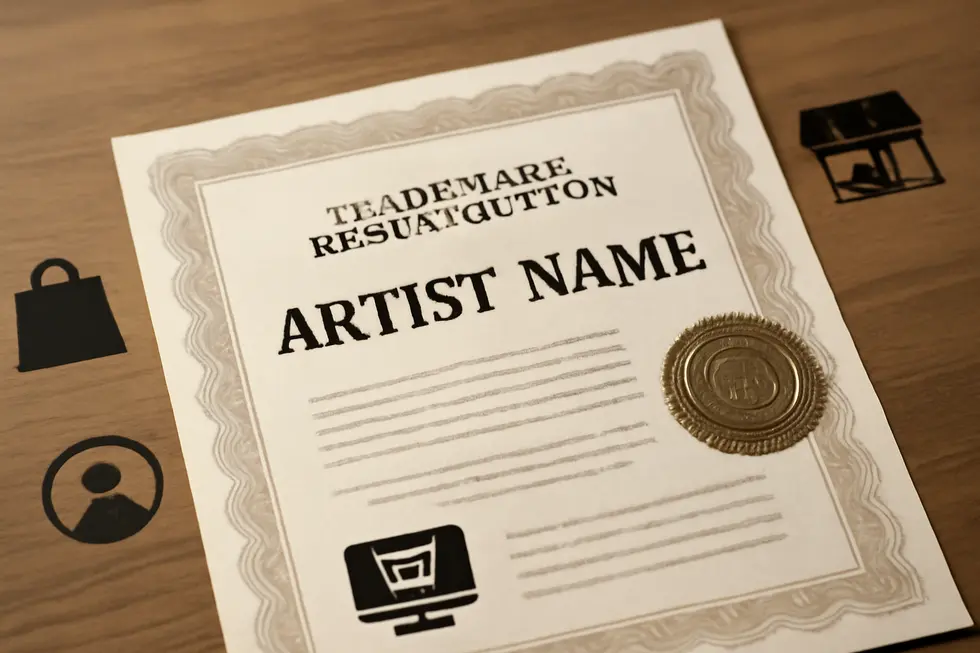Introduction
An artist name often serves as a critical asset, representing reputation, creative identity, and commercial value. For business owners engaged with artists or managing creative brands, understanding how legal protections apply to artist names is essential. Unlike songs, books, or artworks that gain automatic copyright protection, an artist name falls outside copyright’s scope. This distinction matters deeply when safeguarding brand identity and customer association. The following chapters explore why copyright cannot protect artist names, how trademark law steps in as the primary safeguard, and the legal and commercial steps required to secure trademark protection. Together, these insights build a comprehensive understanding crucial for protecting artist names within a business context.
Tables of Contents
Chapter 1: Understanding Why Copyright Does Not Protect an Artist Name
- How Copyright and Trademark Laws Differ in Protecting an Artist’s Name
- Why Artist Names Fall Outside Copyright’s Protection and How Legal Boundaries Define Their Status
- Why Trademark Law, Not Copyright, Secures an Artist’s Name in Commerce
Chapter 2: Trademark Law as the Primary Protection for Copyrighting an Artist Name
- Why Trademark Law, Not Copyright, Secures an Artist’s Name: Legal Principles and Practical Impact
- Navigating Trademark Registration and Enforcement to Secure an Artist’s Name
- The Complex Impact of Trademark Protection on an Artist’s Brand: Economic Value, Public Integrity, and Global Challenges
Chapter 3: Legal and Commercial Processes to Secure Trademark Protection for an Artist Name
- Executing a Rigorous Trademark Search: Foundation for Protecting Your Artist Name
- Navigating the USPTO Process: Application, Examination, and Registration for Artist Name Trademarks
- Sustaining Trademark Rights and Unlocking Commercial Advantages for an Artist Name
Chapter 1: Understanding Why Copyright Does Not Protect an Artist Name

1. How Copyright and Trademark Laws Differ in Protecting an Artist’s Name
Copyright and trademark laws serve distinctly different purposes when it comes to protecting an artist’s identity and creations. Copyright safeguards original creative works that are fixed in a tangible medium, such as songs, paintings, or writings. These works gain automatic protection upon creation, covering the specific expression of ideas but excluding elements like names, titles, or short phrases due to their brevity and lack of sufficient originality to merit copyright protection.
An artist’s name falls squarely into this excluded category since it functions less as a creative expression and more as an identifier. This is where trademark law comes into play. Trademarks protect distinctive signs—such as names, logos, and slogans—that identify and distinguish the source of goods or services in commerce. When an artist uses their name commercially, for performances, merchandise, or other services, securing trademark registration provides exclusive rights to use that name in those commercial contexts. This prevents others from adopting confusingly similar names that could mislead consumers about the origin or affiliation of artistic products or services.
The fundamental legal distinction lies in their objectives: copyright centers on protecting the creative content itself, while trademarks focus on safeguarding identifiers that attribute the source of goods or services and maintain marketplace clarity. Consequently, copyright registration cannot grant an artist rights over their personal name, as it does not cover names or other short phrases.
For artists desiring exclusive control over their professional name, pursuing trademark protection through formal registration is essential. This legal route ensures their name is defended as a valuable brand asset within the commercial arena.
For additional insight into the restrictions of copyright on names and the broader scope of copyright protection, see are titles copyrighted? and TheProjectArtist.com.
2. Why Artist Names Fall Outside Copyright’s Protection and How Legal Boundaries Define Their Status
Copyright law is fundamentally crafted to protect original creative works fixed in a tangible medium, such as music recordings, paintings, books, and films. It safeguards the unique expression of ideas rather than the ideas themselves or simple identifiers. Artist names, however, do not meet these criteria because they function primarily as labels or identifiers, not as original artistic creations. Names are generally short words or phrases that lack the extensive creative authorship and fixed form required for copyright protection. This is why copyright explicitly excludes names, titles, and short phrases from its coverage.
The law recognizes artist names as tools for identification rather than as intellectual creations warranting copyright. While an artist’s work—like a painted canvas—can enjoy copyright protection as an original creative expression, the artist’s name alone is considered a separate category. Although names may be featured prominently in artworks or performances, the protection for how an artist’s name is used in connection to these works falls outside copyright. Instead, there are limited moral rights protections relevant under statutes like the Visual Artists Rights Act (VARA), which protect an artist’s name only when it relates to the integrity or attribution of a specific visual work. VARA does not grant standalone protection for artist names themselves.
In comparison to copyright, trademark law serves as the appropriate framework for protecting artist names as commercial identifiers. Trademarks protect names, logos, or symbols that identify and distinguish goods or services in the marketplace. Since an artist’s name functions as a brand when used commercially—such as on albums, merchandise, or performances—trademark registration grants enforceable rights to prevent unauthorized use by others.
Understanding this legal distinction is critical: copyright guards the creative expression embodied in works, while trademarks defend the commercial identity associated with names. This nuanced boundary clarifies that copyright alone cannot secure exclusive rights to an artist name, making trademark the key legal avenue for protecting and asserting ownership over an artist’s personal branding in commerce.
For more in-depth exploration of trademark protection relevant to artist names, see brand trademark business protection.
Further reading on the limited scope of copyright over artist names and related moral rights is available in this detailed overview of the Visual Artists Rights Act (VARA) and Moral Rights.
3. Why Trademark Law, Not Copyright, Secures an Artist’s Name in Commerce
Copyright law focuses on protecting original creative works fixed in a tangible medium, such as music, literature, or visual art. It specifically excludes names, titles, slogans, or short phrases from coverage because these elements do not constitute a creative expression but rather operate as identifiers or descriptors. An artist’s name is categorized as a brand identifier rather than a creative work; thus, it cannot gain protection under copyright law.
Instead, trademark law is designed to safeguard the types of identifiers that brand a product or service in the marketplace. This includes names, logos, slogans, and other symbols that distinguish one entity’s goods or services from another’s. When an artist uses their name commercially—whether for performances, merchandise, or promotional activities—registering that name as a trademark grants exclusive legal rights connected to those commercial uses. This prevents others from exploiting or imitating the name in ways that could confuse consumers or dilute the artist’s brand.
The protection process differs significantly between copyright and trademark. Copyright protection arises automatically upon the creation of a fixed, original work, without the need for registration, but does not cover names. Conversely, trademark protection requires a formal registration procedure through the appropriate government office, such as the U.S. Patent and Trademark Office, and hinges on the name’s use in commerce and its distinctiveness.
For artists seeking to firmly establish control over their name and maintain their reputation, prioritizing trademark registration is essential. This legal framework not only secures exclusive rights but also reinforces brand integrity in the marketplace. While copyright safeguards creative expression, trademark provides the exclusive domain for unique identifiers like artist names, anchoring them as protected assets.
For a deeper understanding of how trademarks prevent unauthorized use and protect brand identity, refer to this article on trademark protection.
Chapter 2: Trademark Law as the Primary Protection for Copyrighting an Artist Name

1. Why Trademark Law, Not Copyright, Secures an Artist’s Name: Legal Principles and Practical Impact
Trademark law serves as the fundamental legal safeguard for an artist’s name because it protects the brand identity that distinguishes their services or products in commerce. Unlike copyright, which safeguards original creative expressions such as songs, literature, or visual art fixed in a tangible form, trademark law focuses specifically on identifying marks—including names—that signal the source of goods or services to consumers. This distinction is critical: while copyright protection arises automatically for original works, it explicitly excludes protection of names, titles, and short phrases, considering these elements too minimal and non-creative to qualify.
The core role of trademark law is to prevent consumer confusion by providing exclusive rights to an artist’s name when it is used commercially. Registration of a trademark with governmental agencies enhances these protections, granting the artist the power to stop others from using confusingly similar names that could dilute their brand or mislead their audience. These rights can last indefinitely, as long as the trademark remains in active use and meets renewal requirements.
In contrast, copyright law protects the unique expression embodied in an artist’s creations but does not extend to the artist’s name or brand identity. Copyright lasts for a limited duration, typically the creator’s life plus 70 years, and registration is optional but beneficial for enforcement.
For artists, this means their stage or band names are best protected through trademark registration, ensuring exclusive commercial use and preventing unauthorized exploitation of their identity. Meanwhile, their creative works—songs, artwork, performances—remain under copyright protection. The combination of trademark and copyright protections creates a comprehensive framework for securing both the artist’s name and their artistic output.
For further understanding of how trademarks prevent others from infringing on brand identity, consult this comprehensive resource on trademark protections.
Externally, authoritative guidance like LegalZoom’s article on trademarks versus copyrights clearly explains these distinctions and their implications for artists and brands.
2. Navigating Trademark Registration and Enforcement to Secure an Artist’s Name
Trademark law serves as the cornerstone for protecting an artist’s name as a commercial brand, offering legal recognition and exclusive rights that copyright simply does not extend to names. Unlike copyright, which automatically protects original works like songs or paintings fixed in a tangible medium, trademark protection is a deliberate process focused on the use of the artist’s name in commerce. To secure these rights, the artist must file a trademark application with the relevant governmental office, such as the United States Patent and Trademark Office (USPTO). This application requires demonstrating intent to use the name commercially and ensuring the name is distinctive and not confusingly similar to existing trademarks. Once registered, the trademark grants nationwide protection within designated categories of goods or services, effectively linking the name to the artist’s brand identity.
However, acquiring a trademark is only the first step. Enforcement is key to maintaining the exclusive rights granted. Artists or their legal representatives must vigilantly monitor the marketplace for unauthorized use of the name, as unchallenged infringement can weaken trademark rights. When infringement is detected, sending cease-and-desist notices is typically the initial response to deter misuse. Should such efforts fail, legal action may be necessary to prevent others from capitalizing on the goodwill and reputation the artist has built. This active enforcement safeguards not only the artist’s commercial interests but also ensures that consumers are not misled regarding the source or endorsement of goods or services.
It is important to note that trademark protection extends beyond physical products and performances to digital channels, including domain names. Laws like the Anticybersquatting Consumer Protection Act provide additional remedies against bad-faith registrations exploiting well-known artist names.
Thus, while copyright secures the creative output, trademark registration and vigilant enforcement form the essential legal framework for protecting an artist’s name as a valuable commercial asset. For a deeper understanding of the consequences of foregoing trademark registration, consider exploring detailed discussions on the risks of not registering a trademark.
3. The Complex Impact of Trademark Protection on an Artist’s Brand: Economic Value, Public Integrity, and Global Challenges
Trademark law serves as the essential safeguard for an artist’s name, transforming it from a mere identifier into a valuable commercial brand. Unlike copyright, which protects original creative expressions like music or art, trademarks secure the exclusive right to use a name in commerce. This legal protection carries deep economic significance, enabling artists to monetize their identity through merchandise, endorsements, and performances. Without trademark registration, artists risk brand dilution as unauthorized parties might exploit their name, leading to consumer confusion and potential financial loss.
The economic stakes also highlight geopolitical complexities, especially in jurisdictions with divergent trademark frameworks. Countries following a “first-to-file” rule, such as China, allow trademark rights to be claimed by whoever registers the mark first, regardless of prior use. This opens the door to trademark squatting, where bad-faith actors attempt to profit by holding an artist’s name hostage. International treaties like the Madrid Protocol aim to simplify cross-border trademark registration, yet artists must carefully navigate varying national laws and enforcement consistency. These geopolitical realities shape where and how artists can effectively protect and expand their brands worldwide.
Beyond commerce, trademark protection plays a pivotal societal role by preserving the integrity of an artist’s public identity. Strong trademark rights prevent misuse that could mislead fans and degrade the artist’s reputation, thereby maintaining consumer trust and cultural influence. This protection helps an artist’s name remain a reliable symbol of quality and authenticity in an increasingly saturated market.
The intricate balance of economic benefits, societal trust, and geopolitical challenges underscores why securing trademark rights is indispensable for artists. To fully protect their names and reap the commercial advantages, artists must prioritize trademarks over copyright. For deeper insight into trademark’s role in business identity protection, explore this comprehensive guide to brand trademark protection.
For additional details on the legal challenges posed by trademark squatting and international enforcement pitfalls, see Heimlich Law’s analysis of trademark registration risks.
Chapter 3: Legal and Commercial Processes to Secure Trademark Protection for an Artist Name

1. Executing a Rigorous Trademark Search: Foundation for Protecting Your Artist Name
Securing trademark protection for an artist name starts with conducting a thorough and meticulous trademark search. This initial step is critical to determine whether the chosen name is available and registrable, and it significantly lowers the risk of facing legal challenges later on. The process typically begins with a preliminary search using the United States Patent and Trademark Office (USPTO) online database. This free and accessible resource allows artists or their representatives to identify identical or confusingly similar trademarks already claimed in relevant classes tied to artistic services or products. However, a basic search alone is not sufficient. A comprehensive search expands the scope to include close spelling variations, phonetic similarities, and visually alike marks that might not appear in a simple query. By employing strategic search techniques—such as Boolean operators and classification filters—one uncovers trademarks that might otherwise be overlooked yet could cause registration refusals due to the likelihood of confusion.
Because navigating trademark databases and legal nuances can be complex, engaging a trademark attorney is highly advisable. Attorneys conduct exhaustive clearance searches that extend beyond federal trademarks to encompass state registrations, common law uses, and even international registries when relevant. This ensures the artist’s name is clear not only federally but also in any other jurisdiction where commercial use is planned. Moreover, legal experts advise on the appropriate trademark classes that best represent the goods or services connected to the artist name, helping avoid costly errors in the application. Once the clearance phase confirms availability, the trademark registration filing can proceed with the preparation of accurate applications, specimens demonstrating use, or “intent to use” filings where applicable.
In tandem with legal verification, considering the artist’s broader brand and commercial goals ensures that the trademark aligns with long-term strategies, potentially including international protection. This holistic approach to trademark searching and application management maximizes the strength and enforceability of the artist name as a protected commercial asset.
For practical guidance on this multi-step search process, resources like LegalZoom’s detailed trademark search overview offer valuable insights into conducting an effective clearance search. Additionally, understanding the tools and protections trademark law provides supplements what copyright does not cover, positioning artists for successful brand safeguarding. To explore more about protecting your brand identity, see our in-depth discussion on the importance of a legally protected brand trademark.
2. Navigating the USPTO Process: Application, Examination, and Registration for Artist Name Trademarks
Securing trademark protection for an artist name through the United States Patent and Trademark Office (USPTO) involves a structured legal and commercial process. This process begins with a comprehensive trademark search, which ensures that the proposed artist name is neither in conflict nor confusingly similar to existing federal trademarks, state registrations, or common law unregistered marks. This vital step avoids costly legal disputes and delays during registration. Following this, the artist or their representative files a detailed application with the USPTO, specifying the name to be protected and the exact goods or services it will identify, such as musical performances or branded merchandise. Proper classification according to international standards and selection of the correct filing basis—either use in commerce or intent to use—are essential to a smooth application.
Once the application is submitted, it undergoes thorough examination by a USPTO attorney. The examiner reviews compliance with legal requirements and searches for conflicts with earlier marks. If any issues arise, the USPTO issues an office action requiring clarifications, amendments, or legal arguments, which the applicant must address promptly to avoid abandonment. Successful applications then proceed to publication in the Official Gazette, initiating a 30-day opposition window when third parties may challenge the registration. If unopposed or if disputes are resolved favorably, the USPTO issues a registration certificate, granting nationwide trademark rights. Registered trademarks grant the artist exclusive use, ability to enforce against infringers, use of the ® symbol, and enhanced commercial leverage through licensing opportunities.
Maintaining registration requires ongoing filings to affirm continued use and protect the mark’s validity. Due to the complexities of USPTO rules and potential legal challenges, artists often benefit from consulting an intellectual property attorney. This professional guidance helps navigate procedural nuances and secures robust protection for the artist’s brand identity in the competitive marketplace.
For further insights on proactively safeguarding your brand and business identity through trademark law, consider this resource on legally protected brand trademark.
For comprehensive official information, visit the USPTO’s trademark page.
3. Sustaining Trademark Rights and Unlocking Commercial Advantages for an Artist Name
Once a trademark registration for an artist name is secured, maintaining its active status through diligent post-registration requirements is critical. Trademark owners must periodically file specific documents with the USPTO to demonstrate continued use of the mark in commerce. Notably, between the 5th and 6th year after registration, a Section 8 Declaration of Continued Use must be submitted to confirm the artist name remains in commercial use or justify any temporary nonuse. Then, approaching the 10-year mark and every decade thereafter, a combined Section 8 Declaration and Section 9 Renewal Application must be filed to extend the registration’s validity.
Failure to meet these deadlines or ceasing the use of the artist name—typically evidenced by three consecutive years of nonuse—can result in abandonment or cancellation of trademark rights. This highlights that trademark protection is not a one-time effort but an ongoing process requiring attention and compliance.
Beyond legal formalities, maintaining an active trademark delivers significant commercial benefits. It grants the artist exclusive nationwide rights to use their name in connection with the specified goods or services, creating a strong barrier against unauthorized use or imitation. This exclusivity empowers the artist to take enforcement actions such as sending cease-and-desist letters or pursuing litigation against infringers, protecting their brand identity and reputation.
Furthermore, a federally registered trademark enhances the artist’s brand equity. It signals to fans, partners, and licensees that the name is legally owned and safeguarded, boosting credibility and opening doors to potential merchandising, endorsements, or licensing deals. Engaging a trademark attorney can be invaluable in navigating maintenance filings, ensuring proper classifications, monitoring infringement risks, and strategically enforcing rights to maximize both protection and commercial opportunities.
Overall, sustained post-registration diligence combined with vigilant enforcement forms the backbone of preserving and leveraging the trademark rights associated with an artist name. For artists aiming to build and protect their brand, these ongoing legal and commercial efforts are indispensable. For additional insights on how trademarks protect business brands, see this detailed resource on legally protected brand trademark.
Final thoughts
Business owners and artists must understand that while copyright law offers automatic protections for creative works, it does not extend to artist names. Instead, trademark law serves as the critical legal framework for protecting artist names as commercial brands. By recognizing the limitations of copyright and focusing on trademark registration, business owners can secure exclusive rights that enhance brand value, prevent misuse, and foster long-term commercial success. Taking deliberate steps to search, apply, and maintain trademarks is an investment that safeguards the identity and reputation of an artist’s name in the marketplace. This informed approach ensures that your artist name remains an invaluable asset under strong legal protection.
Get your trademark today! Thousands have protected their brand by filing a trademark. What are you waiting for? Start your trademark application!
About us
The globe’s top website for registering trademarks and safeguarding your brand, name, logo, or slogan. We simplify the registration process, provide expert guidance, and empower business owners and artists to protect their intellectual property with confidence.







